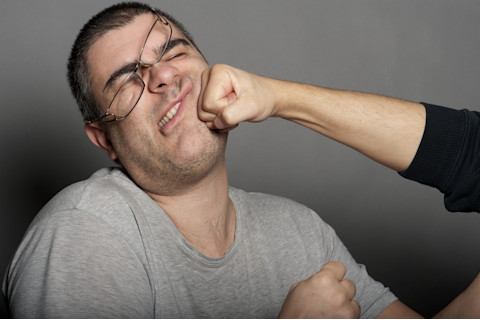
Disputes over land, resources and women have a long history of spawning fisticuffs, and the proof is written on men’s faces. A new theory suggests that our male ancestors evolved facial features specifically designed to take a punch. Researchers found that facial bones commonly broken during a slugfest grew more resilient as time progressed — especially those of our australopith ancestors (the immediate predecessors of the human genus Homo). The reinforced bones were also the same bones that showed the most divergence between males and females, further supporting the “protective buttressing” theory. The findings challenge a long-held hypothesis that attributed the appearance of beefy faces of early hominids to the need to chew hard-to-crush nuts. The current findings, in contrast, suggest that violence was an evolutionary force behind face structure.
Nuts or Punches?
University of Utah researchers David Carrier and Michael Morgan combined ancient fossil data with observations of modern injuries from fistfights. Jawbones were most frequently broken, along with cheek, eye and nose structures, the BBC reports
. These specific bones were the same bones that grew more massive in male australopiths, but not in females. Based on the same researchers’ prior findings, the evolution of reinforced faces coincided with changes in early humans’ hands that allowed for the formation of a fist. Further, recent discoveries
looking at wear patterns on hominids’ teeth suggest they didn’t have an exclusively nut and seed diet, discounting the theory that hard-to-eat foods spurred changes in bone structure. “Together these observations suggest that many of the facial features that characterize early hominids may have evolved to protect the face from injury during fighting with fists," Carrier said in a news release
. Carrier and Morgan published their findings Monday in the journal Biological Reviews
.
Humans’ Violent Past
Morgan and Carrier received criticism
for their original finding regarding fists, and they told the BBC that they expect their current findings to illicit a similar response. The lynchpin of the controversy is an ongoing debate about whether humans were once peaceful creatures, or if violence has always been fundamental to our species. "The debate over whether or not there is a dark side to human nature goes back to the French philosopher Rousseau who argued that before civilization humans were noble savages; that civilization actually corrupted humans and made us more violent,” Carrier said in the news release. “This idea remains strong in the social sciences and in recent decades has been supported by a handful of outspoken evolutionary biologists and anthropologists. Many other evolutionary biologists, however, find evidence that our distant past was not peaceful."
Photo credit: Lavaria Ferreri Liotti/Shutterstock













